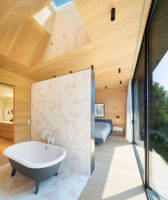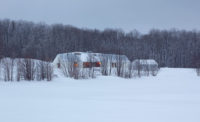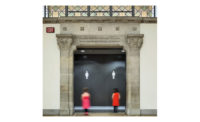Food professionals demand a certain level of quality and functionality in the kitchens of their dining establishments. Some strive for similar setups in their homes. So, when Toronto-based superkül was asked to expand a local restaurateur’s 1870s log cabin in Singhampton, Ontario, the architects took great care in creating a comfortable, efficient 550-square-foot cooking and dining zone for the client and his family within the annex.

A glazed corridor connects the kitchen and new annex to the old log cabin. Photo © Alex Fradkin, click to enlarge.
The clients requested that the annex relate to the land, says superkül principal Andre D’elia. With this in mind, the architects built an elongated bar annex that stretches out onto the site, positioning its fenestration to frame views of the 90-acre property’s open fields. The addition is undeniably modern, but tonally and materially it references the historic structure’s existing elements, including a wood stove, weathered exterior, and honey-toned timber interior.

Black surfaces and hardware provide a dramatic contrast to whitewashed birch plywood (above and top). Photo © Alex Fradkin
“They were inspired by Scandinavian precedents that demonstrate a carefully orchestrated balance between function and refinement, without being too self-aware or precious,” says D’elia. “They asked for clean, simple lines that feel cozy and warm.” To turn the new kitchen into the heart of the home, the architects placed the cooking and dining zones in the same lofty space, dominated by birch plywood, sealed concrete, and plenty of daylight. They achieved this infusion of sunshine by installing glazed doors and windows on three elevations, and canting a bank of skylights within a vaulted section of the ceiling above the dining table.
Perhaps the real focus of the room is its wood-burning cast-iron stove, which echoes an existing unit in the adjacent log cabin. Aligned with a wall of base cabinets, the sink, and refrigerator, this updated hearth is visible from a corridor leading to three new bedrooms, drawing family members and visitors alike.

The kitchen/dining room opens to the outside via glass sliding doors. Photo © Kayla Rocca
Continuing with the overall palette of the annex, the architects specified thin black porcelain for the countertops, wrapped the ventilation hood in black-painted steel, and designed custom blackened-steel recessed pulls for the cabinetry and appliance fronts. In addition to a cooktop, the 3-foot 10-inch-deep by 10-foot 6-inch-long island provides ample counter space for informal noshing. A blackened-steel receptacle built into the corner conveniently stashes logs for the stove. Alongside a wall of full-height cabinetry, a 6-foot 6-inch-wide niche is outfitted with an upholstered bench that has drawers underneath containing the family’s favorite board games.
Glass doors on the kitchen’s southwest corner open onto an outdoor deck and covered breezeway furnished with seating and a floating wood-burning fireplace that doubles as a pizza oven—a perfect hub for a family of active gourmands and their guests.
Click plans to enlarge

Credits
Architect:
superkül
Engineers:
Moses Structural, Bowser Technical
General Contractor:
Jamie Korthals Construction
Consultants:
Coates Creek Millwork
Client:
Robert Wilder and Jacqueline Rothstein
Size:
550 square feet (kitchen); 1,660 square feet (entire annex)
Cost:
Withheld
Completion Date:
November 2019
Sources
Windows:
Tiltco
Doors:
Tiltco and custom
Skylights:
Velux
Countertops:
Laminam
Chairs:
Design Within Reach
Table:
mjölk
Upholstery:
Kai Leather
Lighting:
Gabriel Ross (pendant); RAB Design Lighting (downlights)
Sink:
Kohler
Faucet:
Delta
Refrigerator:
Fisher & Paykel
Dishwasher:
Miele






Post a comment to this article
Report Abusive Comment